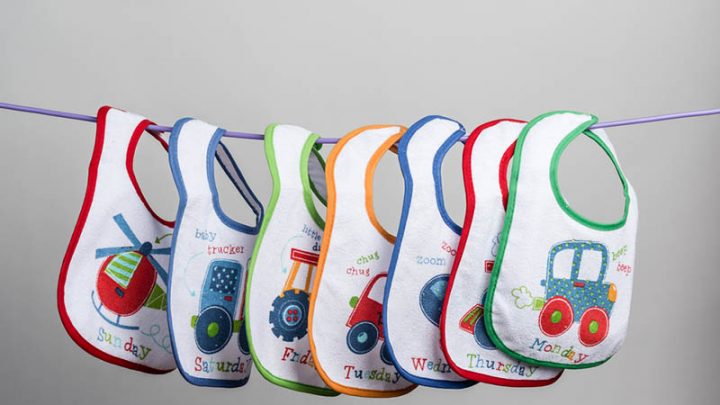A common question about baby gear you’ll find yourself asking is likely to be: How many bibs do I need for my little one? As well as other concerns about supply.
You will have so many things to worry about when it comes to supply maintenance, and: How many bibs do I need? will almost certainly be a question that’s low down on your list of priorities.
Unlike all-natural baby wipes, diapers or similar, baby bibs only have to be purchased once, and how many you need depends on what type they are and how often you put them in the washing machine or have them dry cleaned.
As far as the different varieties go, they all have their own individual pros and cons depending on how often they stain or how absorbent the material they’re made out of is.
When I first started buying bibs I severely underestimated how many I’d need, so I often ended up finding myself without a fresh one when it came to feeding time.
Some people might say they’re optional, but trust me when I say you’d rather have a bib covered in baby food, dribble and spit up than soaking into the baby’s clothes, as the former is a lot easier to clean and won’t require changing the entire outfit.
Whether you share the same sentiment or not is a matter of preference, but I’m going to show you just how crucial getting the right ones can be.
So, How Many Bibs Do I Need?
Without going into too much detail just yet, if you’re an average income family you’re likely to need anywhere between 10-20 baby bibs to ensure you always have some on hand while the others are in the wash.
This number starts to vary based on a few key factors:
1. Access to a washing machine
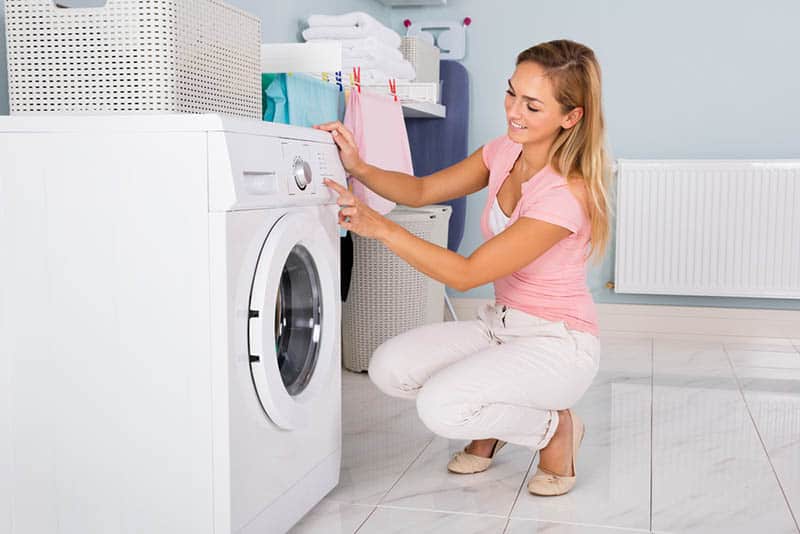
How many bibs do I need?
That depends on your access to a washing machine.
If you’re fortunate enough to own a washing machine of your own, or have a laundromat nearby, you’ll be pretty much good to go with between 10-20 baby bibs, but that’s only if you do your washing frequently.
If you only do your laundry once or twice a week, you might be looking at a higher number, up to 30 in some cases.
However, if you’re currently living on a tight budget and have little or no access to a proper washing machine, you might need up to 40 bibs in some extreme cases, but that’s the absolute worst case scenario.
In reality, you should still be good with around 30-35 bibs, as you’re going to need 3-4 clean ones a day to be safe in case of any extreme circumstances.
However, there is another major factor that might affect this number as well, and that’s the type of feeding bib you are using.
2. Types of bibs
It’s no surprise that bibs come in all different sizes, and some even have different purposes based on the material they’re made out of.
Depending on the age of the child, some types of bibs are better than others.
1. Drool bibs
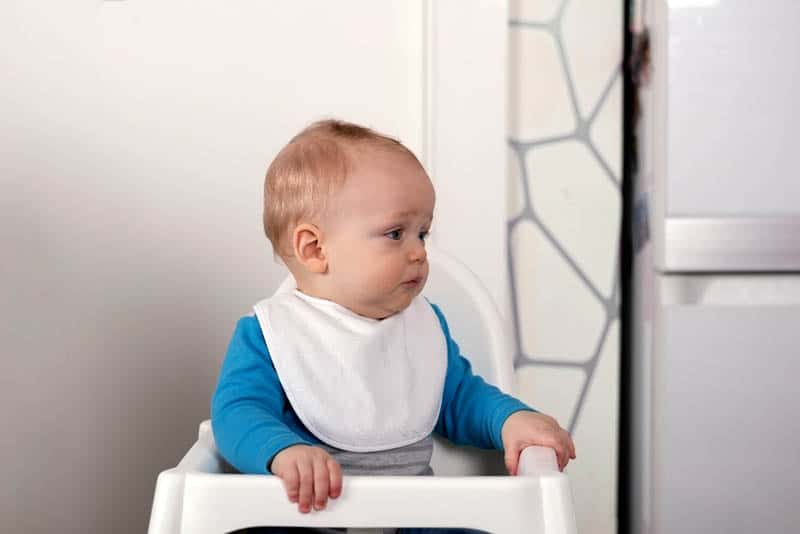
First and foremost we have drool bibs.
These are likely the ones you’re most familiar with, as they’re what you’d call a regular bib.
They’re a fantastic choice for newborns as they’re small, portable, and great at catching the dribble from a drooling baby, stray milk from breastfeeding and the frequent spit ups that occur because the child hasn’t got used to properly pacing himself and swallowing his food yet.
However, they can look pretty basic and somewhat unappealing at times, though there are some exceptions that have lovely designs, however, the best drool bibs by far are the bandana bibs.
These feature a more visually appealing shape and can easily be disguised as part of a clothing ensemble so your child looks a bit more stylish.
While some people might say that there’s no point in getting a drool bib because a burp cloth can perform a similar function, drool bibs are a lot easier to secure and are a lot more pleasing to the eye.
However, if you don’t care too much about your baby gear looking good, you can just go for a burp cloth instead, though be sure to keep in mind that you’ll have to buy a few more than you normally would to meet the demands of both items’ purposes.
2. Feeding bibs
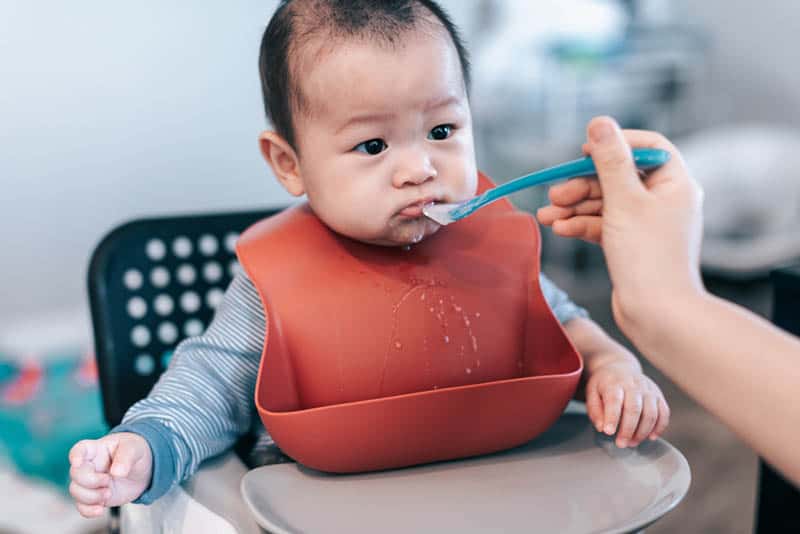
The next tier up are feeding bibs. The main difference here is the addition of the pocket at the bottom.
They’re ideal for older babies who’ve just started teething and have begun eating solid foods.
This is the period where kids start making an even bigger mess than usual, so the extra help is more than welcome for keeping both your child’s clothes, and your floors and tables clean.
These are usually much easier to clean despite being intended for larger messes, as they’re not generally cloth bibs like those intended for droolers, but rather ones made out of silicone and other materials that won’t soak through as easily.
The other alternative are usually plastic bibs with a cloth cover in the front.
These are aimed more at teething babies than messy eaters, but can serve both purposes, much like the former example.
These bibs only really need a nice hand wash and a quick dry on the clothes rack before being usable again, you don’t want to put these in the wash to prevent wearing the silicone or plastic out.
As far as these are concerned, the personalization options aren’t as good as with cloth bibs barring one exception, the Bumkins Superbib.
This is my preferred choice due to the velcro on the neck that allows for easy removal of the bib when I needed it, without worrying about the seal wearing off too quickly.
3. Long-sleeved bibs
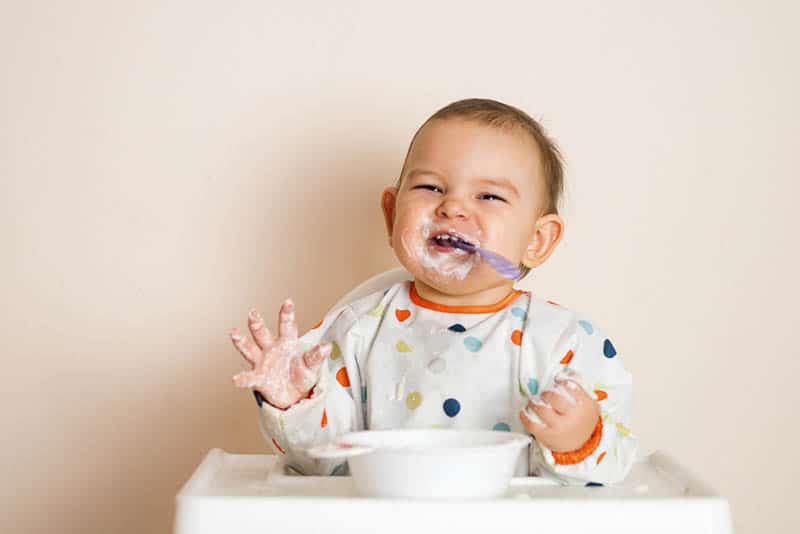
Also known as smock bibs, these are much longer than the previous two examples and serve to add some extra protection for your baby’s clothing.
They’re ideal for when your little one takes his first steps and generally becomes more active.
You won’t normally have to resort to these too often, but they’re a lifesaver when it comes to dinner time at special occasions, as they’ll help protect your child’s clothing, while still allowing him to try and feed himself.
They can be quite stylish in their designs too, but you likely won’t need too many of them.
I’d recommend about 7-8, and only for older kids.
4. Disposable bibs
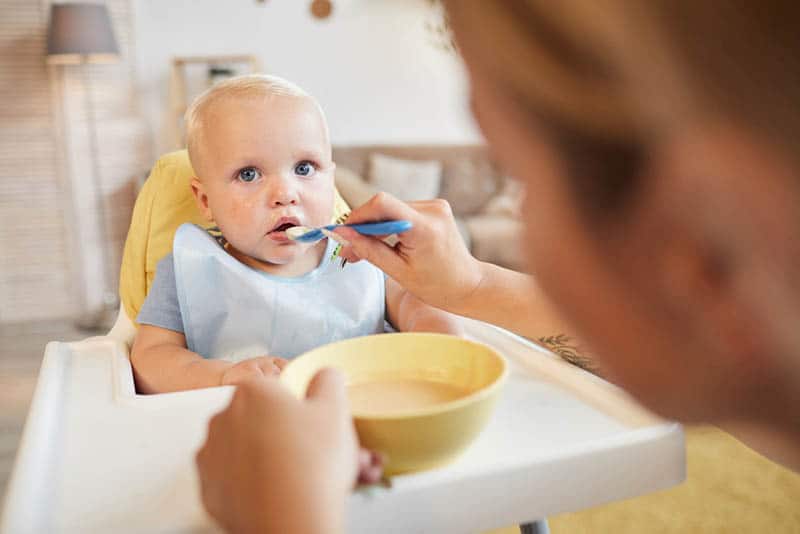
Finally, we come to the “budget” option in the disposable bib department.
As their name implies, these are one-time use baby bibs that you take on a family trip or something similar.
You don’t want to end up carrying a regular bib stained with whatever your kid spits up after meal time somewhere too far away from a clothes hamper or laundromat after all.
These can simply be removed from your child, rolled up, and thrown in a garbage can, ridding you of the problem with very little cost or effort
They’re easy to store and even easier to use.
The main problem arises if you have to use a lot of them, as you’ll probably be going through them like boxes of baby wipes.
With all this in mind to help you better answer the question: How many bibs do I need?
It’s important to optimize bib usage so you don’t end up spending more than you need to.
For newborns, it’s best to use drool bibs to optimize costs, as you won’t really need anything more complex.
Once your child swaps over to more solid foods, you should also consider swapping your drool bibs out for feeding bibs to help deal with the extra mess.
These should help tide you over for the remainder of the bib period.
However, once your child starts handling cutlery and eating food without much assistance, as well as taking his first steps, I suggest investing in a few long-sleeved bibs for when you go out somewhere fancy or over to a friend’s place.
Trust me, you don’t want to get any clothes messy if you don’t have an extra set with you, as your child is likely going to want to run around afterwards, so keeping his clothes clean is a top priority.
For outings where you don’t have access to a laundromat or any other cleaning service, secure yourself a package of disposable bibs to keep on hand, you won’t regret it.
How Does This Change The Math?
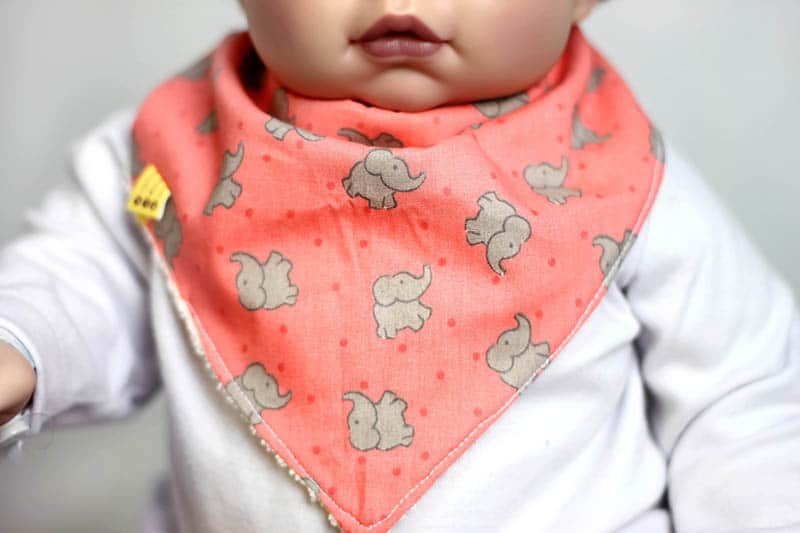
Truth be told, the washing machine aspect is the most important when it comes to quantity, while the types of bibs matter more for price and budget.
Different amounts of bib types work for different kids, so experiment until you find the perfect ratio for your needs and you’ll be good to go.
Make note of how often accidents happen and how many times your child eats in a day, then multiply that by 7 to cover an average weekly requirement.
After that, add about half a dozen more to that number so you can cover an extra day or two should there ever be a need for emergency bibs.
In Conclusion
The answer to the question: How many bibs do I need? isn’t as simple as it might seem at first.
Many people drastically underestimate the required amount and are shocked by just how many they actually end up needing.
The average is somewhere around the 20 mark, give or take 5-10, depending on how often you wash the dirty bibs or go to the laundromat.
Luckily, bibs are only a significant initial investment, as you won’t have to replace them too often during their lifespan and you can sell them later or donate them to other people who might need them.
The other major concern for all you budgeting mammas out there are the various types of bibs, as getting the wrong type at the wrong time might end up increasing costs severely, which is what you’re trying to avoid in the first place.
As mentioned above, drooling bibs are best for newborns and should slowly be phased out once your child starts solid foods, with meaty foods being exceptionally messy, hence the need for an upgrade.
Smock bibs should also be considered after your child learns how to walk and feed himself properly.
Disposable bibs are completely optional, but are a good thing to have on hand for a family outing.
Whatever the case may be, I’m sure you’ll be able to figure out the ideal ratio for your household with this information.
Like this post? Please share or pin it for later. You can also stay in the loop and follow us on Facebook, Instagram or Pinterest.
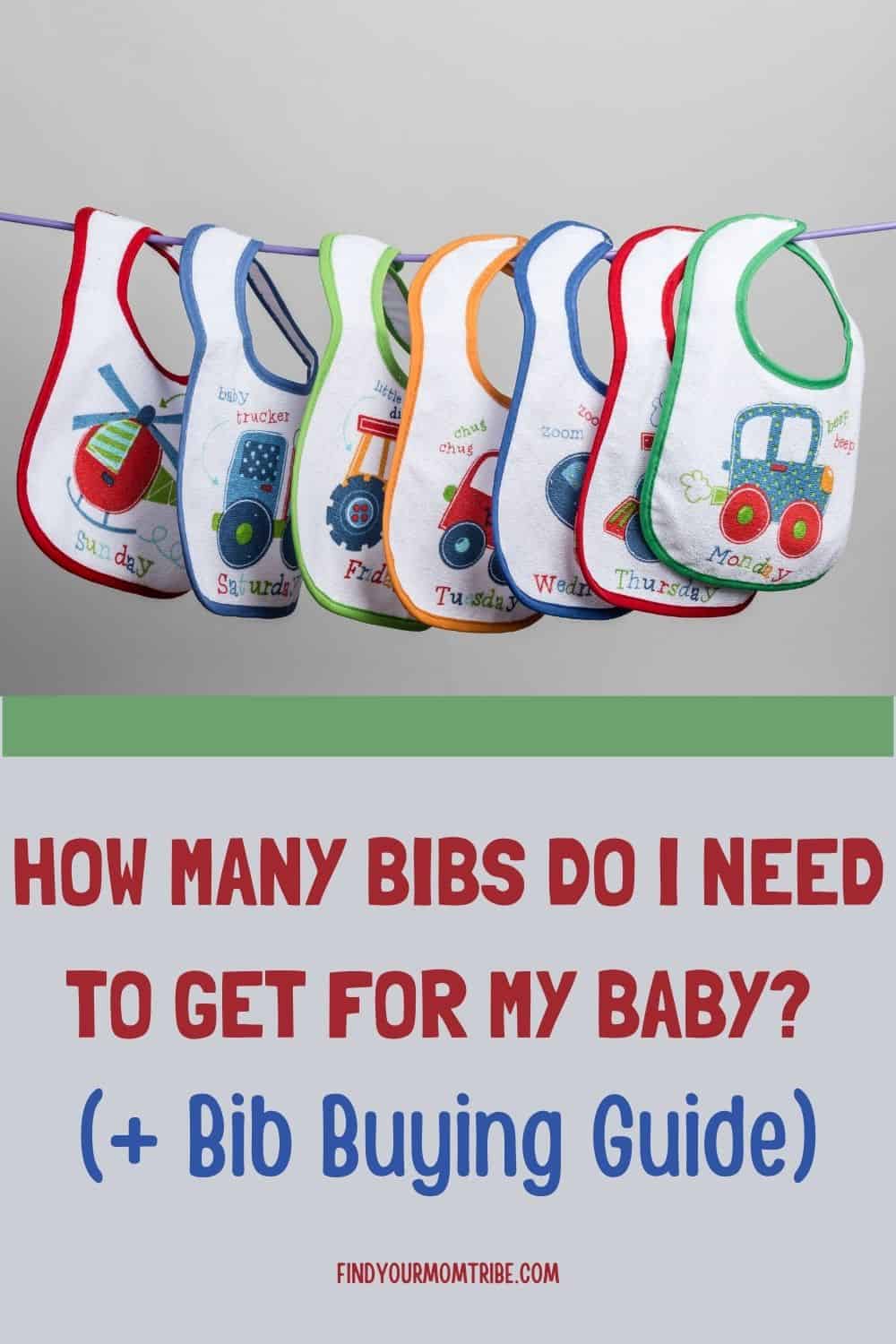
We love honesty! Find Your Mom Tribe is an Amazon Associate and we earn from qualifying purchases through affiliate links at no extra cost to you. Please see our full Amazon Affiliate disclosure for more information.

